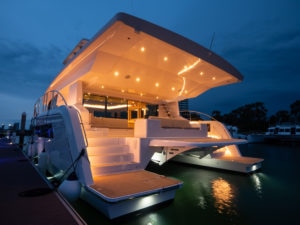
Solar electric catamaran, with kite wing, launched

Silent-Yachts has increased its fleet of oceangoing solar electric catamarans by introducing the new Silent 60. This was recently launched at Silent-Yachts‘ production facility in Thailand, which is led by the Swiss entrepreneur Philippe Guénat.
Eight more hulls are currently under construction, with 17 ordered in total. The catamaran has been built with a 13 sq.m kite wing, a special system that in contrast to conventional sailing yachts, does not require a big mast. Silent-Yachts says the kite sail generates much more power per square meter than a conventional sail.
“The kite system sounds like the perfect match for windy days together with the electric propulsion system of Silent-Yachts,” says the German owner of the first Silent 60. “I am an enthusiast of new technologies which help, little by little, to overcome the ecological challenges we are facing today.”
The kite wing, from Wingit, and all of its components are stored in the bow area.
A two foot high mast is required, which utilises four stays (6 mm Kevlar “ropes”) that need to be fixed to four foldable pad-eyes (this takes a few seconds). After inflation of the kite, says Silent-Yachts, the kite’s thrown overboard where it drifts away with the wind. When in the air, the automatic steering takes over and the pulling rope is released. The kite flies more than 120 meters above the boat.
Bringing it down is the reverse process. The automatic control moves the kite to a position right above the boat where it has the least pull on the rope, it’s then winched down electronically, and collapses above the front deck.
Silent-Yachts says the extra propulsion reduces the consumption of the e-motors, thus extending the range and it can serve as back-up propulsion for emergencies.
The Silent 60 is designed to go everywhere as a true ocean-going cruising yacht, says its makers. With a crew of two (or more) it can cruise efficiently for up to 100 miles a day for weeks. At the same time, the arrangement of the components enables the system to power all on board systems without the need of fuel to power a generator. The yacht’s cruising speed is 6-8 knots but it can be faster when needed, reaching 20 knots maximum speed.
Rather disappointingly, images of the kite in action are not yet available.
